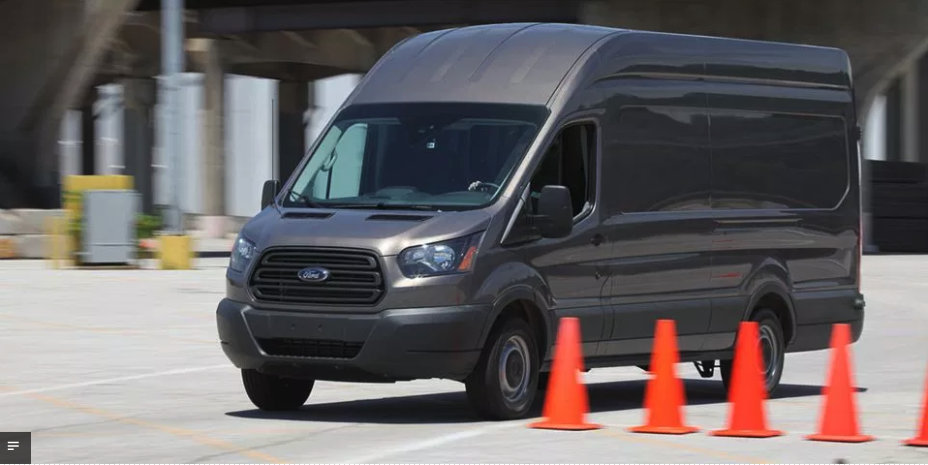First Drive: 2015 Ford Transit

Story and photo by John LeBlanc
KANSAS CITY, Missouri — The next time you need to rent a vehicle to move your graduating daughter out of your home, have a courier package home-delivered, get a ride from the airport or are considering a recreational vehicle for your retirement years, you may be looking at the new Ford Transit.
The new-for-2015 Transit is the U.S. automaker’s long-awaited replacement for its E-Series, Ford’s old full-size commercial van that started life as the Econoline in the 1960s. Like its smaller Transit Connect sibling, the new Transit is a result of the automaker’s “One Ford” product strategy that calls for one model to be designed for all global markets. (To wit, while the Econoline/E-Series was strictly a North American offering, Ford says the Transit will sell in over 110 markets on six continents.)
The Transit’s long development history (since 1965 in the United Kingdom) and global sales weight means there will be a plethora of configurations (upwards of 2,000, or “best in class,” according to Ford) compared to the more limited E-Series. Transit customers can pick from: van, passenger wagon, chassis cab only or cutaway body styles; three body lengths and two wheelbases for the van and wagon, plus three roof heights, along with XL and XLT levels of trim.
In addition to more customization, Ford is also touting the new Transit’s improved fuel economy estimates over the old E-Series — an operating expense that’s keeping commercial fleet managers up at night these days. As such, there are no V8s on the Transit’s engine menu. The standard mill is a 3.7-litre, six-cylinder gas engine, making 275 horsepower and 260 pound-feet of torque. An optional twin-turbocharged 3.5-litre gas six puts out 310 hp and 400 lb.-ft. The third engine choice, a 3.2-litre, five-cylinder diesel, will also become available with 185 hp and 350 lb.-ft. All three Transit engines are mated to a six-speed automatic transmission.
The best examples of how much more fuel-efficient the Transit is over the E-Series are the medium-roof regular wheelbase wagons with the optional turbo-gas six. They score 14 miles per gallon in the city (16.8 litres per 100 km) and 19 mpg highway (12.4 L/100 km), according to U.S. Environmental Protection Agency estimates (no Canadian figures, yet). That’s an improvement of 46% compared to the 10-mpg city/13 mpg highway ratings for the old E-Series’ optional 6.8-litre, 10-cylinder gas engine. According to the EPA, that translates into fuel savings of $1,700 (US) annually.
While saving fuel is a crucial bonus, the new Transit is also more capable as a hauler; 600 more pounds in maximum payload capacity across all sizes of Transit vans versus comparable E-Series vans. New Transit vans can carry more stuff than rival vans from General Motors and Chrysler, too — as much as 4,650 lbs. of maximum payload capacity, and offer a maximum towing capacity of 7,500 lbs.
Overall, the new Transit is also leagues ahead of the E-Series from a space efficiency standpoint and delivers a few “best-in-class” storage numbers. For example: Transit offers a “best-in-class” gas engine maximum cargo capacity of 13,799 litres – 75% more than the largest E-Series; extended-length Transit wagons offer “best-in-class” cargo storage (2,846 L) behind the last row of seats in the 15-passenger version; Transit high-roof van models offer “best-in-class” cargo height; and high-roof wagon models deliver (yawn…) “best-in-class” passenger compartment height, allowing passengers as tall as six feet, four inches to stand upright.
Transit also has a “best-in-class” rear door opening height. But you may have already guessed that.
In regards to its driving characteristics, the 2015 Ford Transit drives a bit better than I expected for such a vast and tall vehicle, and way better than the Neanderthal E-Series. I got to pilot a short wheelbase, low roof 2015 Transit 250 with the optional turbo-six. And while the top-heavy and large vehicle won’t set any Nürburgring lap records, the drivetrain is relatively refined, with smooth linear power and smooth shifts from this engine and transmission combo. Ford PR types wisely added a half-maximum payload, which gave a flavour for how the Transit would be driven. Yes, the Ford full-size van leans quite a bit compared to a passenger car, but at least the lean is progressive, with handling that can be described as “predictable.”
Inside, the Transit is more car-like than the E-Series too, mainly because all of its driver’s instrumentation, steering wheel, HVAC and audio controls come right from Ford’s cars. And for the average driver who would spend the majority of their work day in a Transit, note that its passenger seat lifts up for storing bigger items, and there are plenty of cubbies and storage bins for the requisite laptops, clipboards, lunch boxes and tool kits such working vans must accommodate.
Because of the many Transit body styles and configurations, the pricing matrix is quite complex. It’s bracketed at the low-end by the short wheelbase $32,449 Transit 250 Cutaway Low Roof and the high-end by the short wheelbase $44,499 Transit 350 HD High Roof Extended Length with double sliding side cargo doors.
With its improved fuel economy estimates, additional body styles and available configurations and more refined driving characteristics, the new 2015 Ford Transit should make anyone forget the long-in-the-tooth-but-iconic E-Series. It also gives Ford a viable contender in a class of big-but-efficient new vans from Fiat-Chrysler, Mercedes-Benz, and Nissan.





![[del.icio.us]](https://www.straight-six.com/wp-content/plugins/bookmarkify/delicious.png)
![[Digg]](https://www.straight-six.com/wp-content/plugins/bookmarkify/digg.png)
![[Facebook]](https://www.straight-six.com/wp-content/plugins/bookmarkify/facebook.png)
![[Google]](https://www.straight-six.com/wp-content/plugins/bookmarkify/google.png)
![[Reddit]](https://www.straight-six.com/wp-content/plugins/bookmarkify/reddit.png)
![[StumbleUpon]](https://www.straight-six.com/wp-content/plugins/bookmarkify/stumbleupon.png)
![[Twitter]](https://www.straight-six.com/wp-content/plugins/bookmarkify/twitter.png)
![[Email]](https://www.straight-six.com/wp-content/plugins/bookmarkify/email.png)